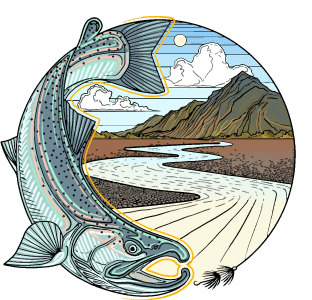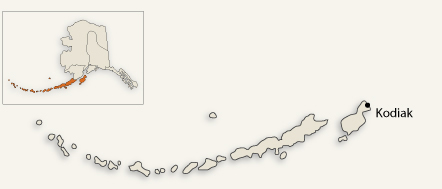Kodiak Archipelago: The Big Picture
The Kodiak Archipelago is a group of islands approximately 250 miles south of Anchorage, located 33 miles off of the Alaska peninsula in the Gulf of Alaska. At 3580 square miles, the island of Kodiak makes up the bulk of the archipelago's 5000 square miles, with the rest being filled out by Raspberry, Afognak, and Shuyak islands. The Kodiak archipelago is the southwestern remnant of the Kenai range, and as such is a convoluted landscape, thrust into existence by the plate tectonics of the Aleutian trench and formed by countless glaciers during the last Ice Age. Like Southeast Alaska, Kodiak's high amounts of rainfall and lumpy topography result in many small, clear streams.
As with most offshore islands, the only way to reach Kodiak is by plane or boat, and the public road system consists of 3 roads radiating out from Kodiak township for a total of roughly 70 miles. There are plenty of fishing opportunities on the road system, as it gives access to over 10 river drainages and 20 lakes, some of which are stocked by the state to enhance fishing opportunities. In addition to freshwater fishing, Kodiak has numerous accessible saltwater fishing areas.
Most Kodiak rivers are short, 3 to 10 miles in length, and support populations of native trout, char, and salmon. A typical creek starts off high above the valley floor. These high-gradient headwaters are characterized by cataracts interspersed with pools and undercut banks. As the creek nears its saltwater terminus the gradient flattens, slowing the current and deepening the creek as it winds through a meadow. The final part of the stream is the inter-tidal zone where the creek depth varies dramatically between high and low tide. As the tide moves in the salmon and trout move in with it. This often provides great fishing for bright salmon and hungry trout.
The tidal range in Kodiak is rather small due to its oceanic location, but the tides can still fluctuate up to 10 feet a day, and at low tide there are many exposed mudflats that present a danger to the unwary angler. Use caution, carry a tide book, and always fish with a partner. Keep you eyes open for bears. The United States Fish and Wildlife Service (USFWS) has a tremendous amount of information on traveling and fishing safely in bear country. As the gateway to the stormy Aleutian Islands, Kodiak has a reputation for fierce and somewhat unpredictable weather. The weather on Kodiak can change more quickly than in just about any other region of Alaska. Watch the forecast and carry just about everything you will need to stay warm and dry.
Fly Fishing in Kodiak: When and Where to Go
Spring: April & May
Unlike other parts of the state, Kodiak enjoys an oceanic temperate climate that leaves some fresh waters open for fishing year-round. While fishing in some waters can be enjoyed all winter, the fishing is generally slow until ice-out, which occurs during April and May. At ice-out, many lakes have good fishing for rainbow trout and Dolly Varden . During May, the Dolly Varden out-migration begins as these fish start following the salmon fry to the ocean. Salmon fry are the principal springtime food source for Dollies, and Dollies feed with reckless abandon during this season. There are many all-purpose minnow patterns (think Clouser Minnows, Epoxy Mini Minnows and Chumpy Fry) that are surefire producers for Dollies feeding on salmon fry. As the fry reach the saltwater, they tend to mass along the shoreline, lingering in the shallows to avoid predation. As the Dollies come into the skinny water looking for an easy meal, the estuary and saltwater beach fishery for them really heats up.
Steelhead can also be found during this season in some watersheds, but they are primarily fall-run fish, staging for their spawning periods after overwintering in lakes. More on steelhead later...
Summer: June and July
The start of the summer season in Kodiak is heralded by the return of the sockeye salmon. The archipelago hosts good runs of these early returning, hard-fighting salmon, and a few of these runs are accessible via the road system. Reds, so named for the brilliant crimson coloring of the spawning phase, are sometimes recalcitrant biters, and will often frustrate the angler faced with so many unwilling dance partners. Have no fear, just persevere...sockeye are often attracted to small offerings, and flies such as the Sockeye Lantern, Montana Brassie, Copper Swan, and Chartreuse Mini Krystal Shrimp will sometimes "crack the code" and result in hookups.
June and July also represent the peak of freshwater king salmon availability, but most of the rivers hosting these bruisers are off the road system and have to be flown in to. These rivers offer amazing fly fishing opportunities with many wide open, waist-deep riffles and runs. Two of the most prolific are the Karluk River and the Ayakulik River. As with Southeast kings, flies such as the Stinger Prawn, Signature Intruder, Hareball Leech, and other large-profile offerings fished on sink-tip lines are the way to seal the deal.
Dollies are readily available in June and July with good fishing to be had on saltwater beaches, especially near the mouths of salmon streams. As with the springtime fishing, minnow flies like the Stinger Clouser and AK Clouser Minnow are the patterns to have on hand.
Late summer/Early fall: August and September
August in Kodiak can be called the Month of the Humpy. Every August the pink salmon begin their spawning runs, ascending nearly every river, stream, and trickle on the islands. In July these small salmon begin massing in the estuaries of their spawning streams, and by August their run is in full swing, providing the fly angler with great opportunities to catch fish until their arms are sore. Pinks are ready and willing biters, providing the best chance for the novice fly angler to experience what the fun is all about. These scrappy little fighters are particularly fond of the color pink, and will readily chase such offerings as the Humpy Hooker, Sandy Kandy, Pink/White Clouser Minnow, and Starlite Leech when fished on a floating line.
Late August is also the beginning of the coho run. These hard-fighting salmon are sometimes tough to target due to the inordinate amount of pink salmon in every stream, but as the humpies die off the silvers are more accessible. There are many effective fly fishing techniques for silvers, including swinging, nymphing, stripped sub-surface, and top water techniques. For swinging and stripping, flies such as the Chartreuse & White Clouser and the Dolly Llama in a variety of colors are deadly, while nymphing with Coho Kryptonite can be just as effective. The top water standby is the Pink Pollywog , but many varieties including the Popper Wog and Foxy Wog are excellent producers as well.
August and September are also the months that the Dolly Varden, fat from their ocean sojourn, return to the streams in preparation for spawning. During the salmon spawn, dollies often lurk behind the redds of spawning salmon, looking for an easy meal of stray eggs. During this time, flies such as the Unreal Egg and Glo Bug are very effective. Beads are also a top producer during this time, but make sure you have a wide selection to readily "match the hatch." As the season progresses and the salmon are dying off after spawning, flesh flies such as the Twofer or Battle Creek Special can be effective as well.
Late Fall: October and November
If August is the Month of the Humpy, October is the Month of the Steelhead in the Kodiak archipelago. As mentioned earlier, these sea-going rainbow trout are primarily fall-run in the archipelago, with some rivers receiving runs numbering in the thousands of fish. Most systems, however, hold moderate runs of fish, often numbering 200 adults or fewer. Most notable for its exceptional fishery is the Karluk River, which hosts Alaska's second largest run of steelhead behind the mighty Situk of Southeast. With a recent ten-year average count of 8,000 returning adults this jewel is certainly among the world's top steelhead-producing systems. Swinging with switch rods and two-handed Spey-style rods is becoming increasingly popular in Alaska and flies such as the Mini Intruder, Rocket Man, and Signature Intruder are good patterns to have in any swingers stash. Nymphing is also effective for these hard fighters, and patterns such as Steelhead Glo Bugs, Liquid Wrenches, and the Beadhead Veiled Assassin have proven effective over the years. And of course a variety of beads are deadly for nymphing for steelhead as well.
October also brings the last of the coho salmon run, and these fish are often the largest of the year. Once again, Dolly Llamas, Hareball Leeches, and Coho Kryptonite are the fly of choice for the late season coho angler.
As the salmon run dwindles, the dollies enter their spawning and overwintering phase, seeking out lakes in which they can spend the winter months resting on or finning slowly above the bottom. The late season dollies are the vacuum cleaners of the fish world, eating every last egg and scrap of flesh in preparation for the long winter ahead. Pale colored "dead" beads are often effective during this time, as are flesh flies.






I will be staying in Karluk August 31st to Sept 5th. We have a small boat to navigate up river to weir. I was wondering if you know if there is a float plane service that would take us up River in AM then pick us back up later in the afternoon? I have bought your silver salmon fly selection. If I need additional flys for the time of year please let me know.
Hi Bob,
Mike here. I don’t know if there is anyone offering day trips that could pick you up in Karluk. There is a company called Sea Hawk Air (907-486-8282) based out of Kodiak. I believe that they offer days trip for there, but not 100% sure on that. Are you looking to do a little trout fishing? As far as your flies go, the selection you have will catch fish. You may want to stock up on a couple of those patterns like the Dolly Llamas, Clouser Minnow and Starlite Leeches. We can talk about which ones and quantities if you like. I can be reached here at the shop M-F (907) 586-1550 or you can shoot me an email to mike@alaskaflyfishingoods.com. More than happy to help.
Best regards,
Mike
I will be in Karluk next year in early Oct. Do you believe a 7wt, 10′ switch will suffice for the steelhead/, or would you ramp up to an 8wt, 9′? I will be swinging flies primarily.
That would be a fine choice for steelhead up that way. The only reason I would suggest sizing up would be so you can throw bigger flies more easily.
Cory